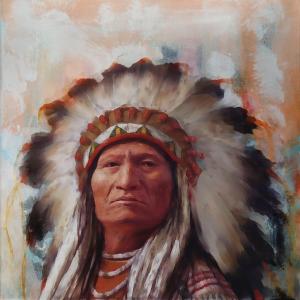Sale on Canvas Prints! Use code ABCXYZ at checkout for a special discount!

A Brief Historical Background of American Indians or Native Americans
Many thousands of years past, late within the geological period, humans journeyed across the Vitus Bering land bridge, from Asia into Alaska. Their descendants explored on the geographic area of North America. As early as a thousand before Christ, they'd lined nearly the whole continent. It’s not renowned once the primary individuals arrived within the Americas. Some archaeologists (scientists WHO study the remains of past human lives) believe it'd are concerning 12000 before Christ.
Over thousands of years, American Indians have developed a good vary of languages, customs, and civilizations. There are as many various social group nations within the Americas as there are nations in Europe, Asia, or Africa, and there's the maximum amount selection among them.
Ten thousand years past, once the glacial period complete, changes in climate and increasing populations impressed some Native Americans tribes to experiment with growing completely different crops. Some became extremely good farmers. As early as concerning 5500 B.C., tribes in United Mexican States cultivated corn and squash. They raised turkeys, llamas, and guinea pigs for food and that they hunted deer and bison. They frequently burned off patches of land to stay it in pasture, therefore the animals would return to graze. Several tribes on the coasts hunted ocean mammals from boats and caught fish, employing a form of economical strategies.
After 2000 before Christ, some Native Americans developed states, every governing thousands of individuals. They established intensive trade routes across the continents. And that they used wares rafts and alternative boats to ship their product from one commerce purpose to a different. In South America, llamas provided transportation toward land.
From the current region of the mid-western U. S. to southern Republic of Peru in South America, centers of presidency were marked by huge mounds of earth. Most of those mounds were flat on prime, with palaces and temples engineered on them. Some were interment sites of honored leaders. Yank Indian cities were as massive because the cities in Europe and Asia at that point. Their fine design remains greatly loved.
European invasions of land began with Columbus's voyages to the "New World" in 1492. The Europeans brought diseases with them, as well as pox and rubeola. These unknown diseases unfold quickly among Native Americans. They were worn out the populations of the many native cities.
The Europeans started colonizing solid ground so as to cultivate new farmlands and build new jobs for the growing populations of Europe. To do so, they typically fought Native Americans social group nations for the land. Many factors gave the Europeans the advantage in these conflicts. First, they'd some immunities to their own diseases. Therefore they weren't as ruined by them as Native Americans were. Second, the Europeans had horses and guns that overcome the Native Americans' hand weapons and arrows in battle. Third, European settlements within the Americas grew at such a rate that the Europeans' descendants eventually outnumbered the native individuals
Native Americans social group nations resisted colonization, however eventually; several were forced to surrender their lands. Within the regions of contemporary southern North American nation, the U. S., and southern South America, survivors were gathered up and involuntarily emotional to specific areas, referred to as reservations. In Mexico, Central America, and northern South America, the native individuals were forced to measure as peasants and laborers, below Spanish rule. In the previous couple of decades, developments in transportation and earth-moving machinery have created it profitable for outsiders to colonize the tropical lowland forests. Currently the approach of life for those social group nations, too, is vulnerable.
Today Native Americans populations across each continents area unit another time on the increase. Native American leader’s area unit achieving larger political success in fighting for the rights of their peoples. Additionally, recent widespread concern over human rights has prompted government’s et al to respect Native yank cultures and traditions once responding to their wants.